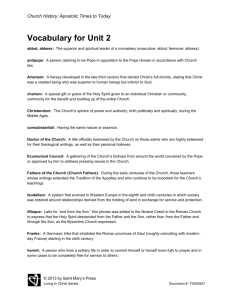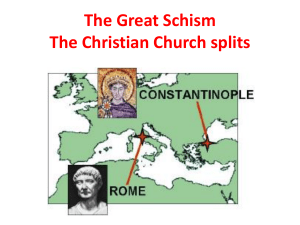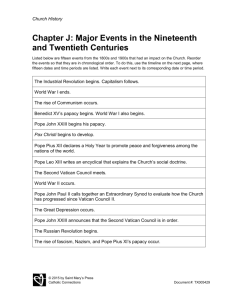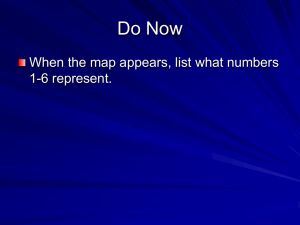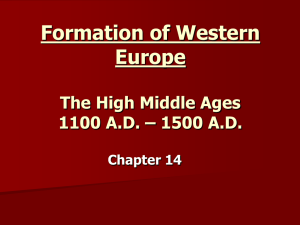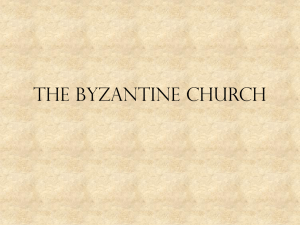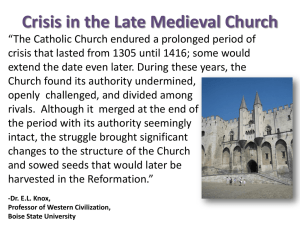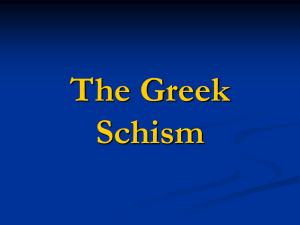Orthodox Churches Today
advertisement
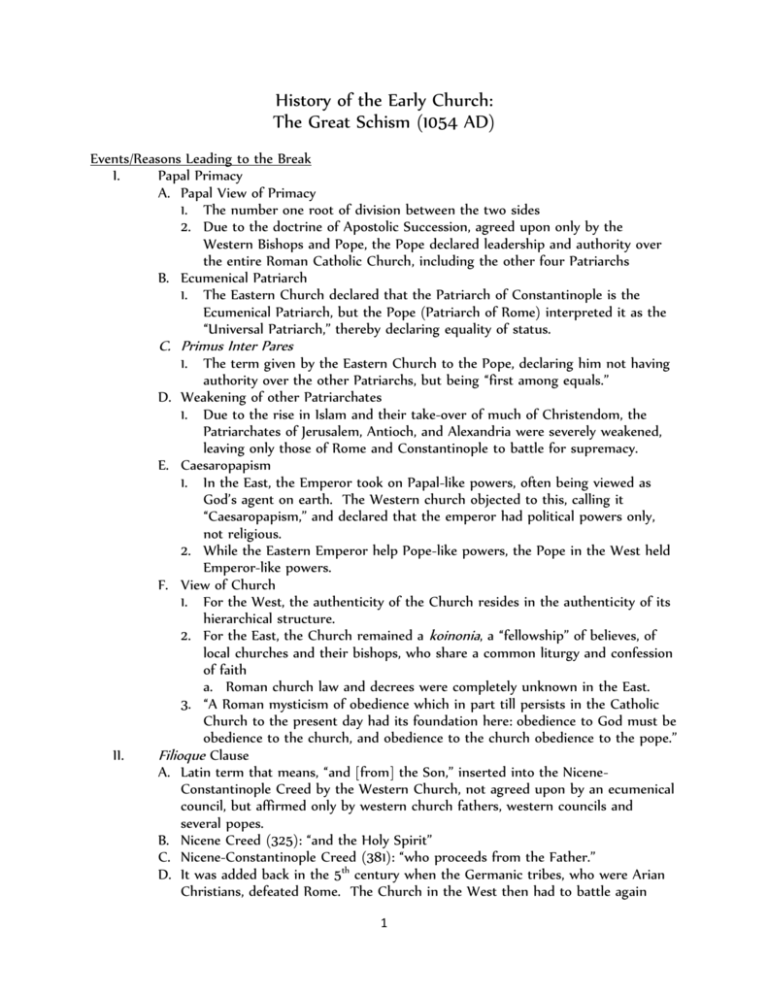
History of the Early Church: The Great Schism (1054 AD) Events/Reasons Leading to the Break I. Papal Primacy A. Papal View of Primacy 1. The number one root of division between the two sides 2. Due to the doctrine of Apostolic Succession, agreed upon only by the Western Bishops and Pope, the Pope declared leadership and authority over the entire Roman Catholic Church, including the other four Patriarchs B. Ecumenical Patriarch 1. The Eastern Church declared that the Patriarch of Constantinople is the Ecumenical Patriarch, but the Pope (Patriarch of Rome) interpreted it as the “Universal Patriarch,” thereby declaring equality of status. C. Primus Inter Pares II. 1. The term given by the Eastern Church to the Pope, declaring him not having authority over the other Patriarchs, but being “first among equals.” D. Weakening of other Patriarchates 1. Due to the rise in Islam and their take-over of much of Christendom, the Patriarchates of Jerusalem, Antioch, and Alexandria were severely weakened, leaving only those of Rome and Constantinople to battle for supremacy. E. Caesaropapism 1. In the East, the Emperor took on Papal-like powers, often being viewed as God’s agent on earth. The Western church objected to this, calling it “Caesaropapism,” and declared that the emperor had political powers only, not religious. 2. While the Eastern Emperor help Pope-like powers, the Pope in the West held Emperor-like powers. F. View of Church 1. For the West, the authenticity of the Church resides in the authenticity of its hierarchical structure. 2. For the East, the Church remained a koinonia, a “fellowship” of believes, of local churches and their bishops, who share a common liturgy and confession of faith a. Roman church law and decrees were completely unknown in the East. 3. “A Roman mysticism of obedience which in part till persists in the Catholic Church to the present day had its foundation here: obedience to God must be obedience to the church, and obedience to the church obedience to the pope.” Filioque Clause A. Latin term that means, “and [from] the Son,” inserted into the NiceneConstantinople Creed by the Western Church, not agreed upon by an ecumenical council, but affirmed only by western church fathers, western councils and several popes. B. Nicene Creed (325): “and the Holy Spirit” C. Nicene-Constantinople Creed (381): “who proceeds from the Father.” D. It was added back in the 5th century when the Germanic tribes, who were Arian Christians, defeated Rome. The Church in the West then had to battle again 1 III. IV. V. VI. VII. against the Arians, and so started adding “and the Son” as a way of demonstrating that the Son was not somehow less than the Father. E. Added on the basis of John 15:26 – “When the Counselor comes, whom I will send to you from the Father, the Spirit of truth who goes out from the Father, he will testify about me,” arguing that if the Spirit is sent by the Son, then he also proceeds from the Son. 1. To this the Eastern Church argued that they were adding a “principle of being” to the Godhead. 2. Anselm tried to make clear in response that the Holy Spirit was sad to proceed from the Son as well as from the Father, “not according to his essence, which is common [to all three persons], nor according to his person, which is unto itself, but according to his relation” to both the Father and Son. F. The West made it an official inclusion at the Council of Toledo (not ecumenical) G. The Council of Ephesus (431) had a canon that anathematized anyone who added to the Creed as it had been agreed upon at the Council of Constantinople, and to the Eastern Church, this included even the Pope. Iconoclasm A. In response to growing Muslim critiques of icons/statues/etc., the Eastern Emperor Leo III (8th century) declared that the veneration of icons was illegal. He forbade kneeling before pictures or images and in 730 he ordered all but crosses to be taken down in churches. Some Eastern Bishops rejected the policy, but others upheld it, believing that the Emperor was God’s agent on earth. The Pope objected to the policy and to the emperors role as God’s agent on earth. Liturgical Practices, Particularly the Eucharist A. The west adopted the tradition of using unleavened bread for the Eucharist, which the East saw as an innovation. B. Great debates over the “real presence” of the Eucharist. Was it a symbol or a sign of the body of Christ, or was it literally the body and blood of Christ, being broken again (a.k.a. sacrificed)? C. The East was interested in solving theological problems along philosophical grounds, while the West was interested in practical matters. Clerical Celibacy A. In the West, the Popes declared that priests must be celibate in order for their sacramental blessings to be realized. In the East, the parish priests could be married if their marriage had taken place when they were still laymen, but only below the rank of Bishop. B. The West referred to priestly marriages as “concubinage.” Lack of Communication A. Language differences were drastic by 1054; The Roman popes no longer knew Greek and the ecumenical patriarchs knew no Latin. Cultural Differences A. The Greeks appeared arrogant, pedantic, and devious to the Latins; the Latins uneducated and barbarous to the Greeks. The Rise of Islam I. Started as the “heresy of Mohammed” II. Mohammed (570-632) 2 III. IV. V. VI. VII. 622 – first year on the Muslim calendar 630 – His movement grew so much that he captured Mecca 652 – Koran shows up Series of conquests occurred over the next 100 years; they took from the Eastern empire over half of its territory – all of North Africa; ended European control over Middle East and North Africa The Eastern Churches were under the dictates of Muslims Missions of the Time I. The British Isles A. Celtic Churches in Ireland, West and North England 1. Irish monks had preserved and copied manuscripts 2. Severely weakened church from Viking attacks 3. Rome had issues with the Celtic Church, because it didn’t acknowledge the people, had Easter on different days, the monks married and had different haircuts. B. Southern England – Pope Gregory I sent Augustine of Canterbury there to evangelize II. Germany A. Boniface (680-754), an English monk, led the mission 1. Cut down an oak tree, which was sacred to Thor, god of Germany 2. Mass conversions from the Rhine to the Danube 3. First to use women missionaries III. Holland and Belgium won by Wilibord (658-739) in 690. IV. Scandinavia A. Viking homeland; Danes, Swedes, Fins all converted by monk missionaries B. Norway converted in 1000 and Christianity made the state religion in Sweden and Iceland V. Missions during these years primarily took place in the West, since the East was focused on fighting off Muslims. VI. Russia A. Vladimir accepted Christianity in Russia, which eventually became the Russian Orthodox Church (10th century). B. Shortly after the schism in 1054, the Russian Tzar declared Moscow to be the third Rome. Excommunications I. Ecumenical Patriarch Michael I Cerularius (Bishop of Constantinople) supposedly sent a letter to Pope Leo IX declaring that the Western practices were “Judaistic.” Pope Leo IX had a reply letter written, in which he made a defense for all of the allegations, particularly a defense of papal supremacy. Cerularius made an attempt to cool the debate, but the Pope was enraged. II. In April 1054, Pope Leo IX and his delegates arrived in Constantinople, brought a letter declaring the West’s supremacy over the east, which was copied and sent throughout the empire. Pope Leo IX died on April 19, 1054 and the Patriarch of Constantinople continued to refuse to deal with the allegations. 3 III. IV. July 16, 1054, three Western legates entered the Hagia Sophia during a Mass and placed a papal bull of excommunication on the altar. The legates fled back to Rome, leaving Constantinople in riots. The bull was burned and the legates were anathematized. The Great Schism began. Temporary reconciliations occurred over the next several centuries, until the Fourth Crusade, when the break became official and irreconcilable for the rest of history to date. Crusades I. Seven Crusades, along with several other smaller crusades II. The first and the fourth are the most important A. The first crusade was started by Pope Urban II in 1095 who attempted to rescue the holy places, particularly Jerusalem, Nazareth, Bethlehem, and slowly lost the land. B. The fourth crusade was led by Pope Innocent III, the “Zenith of Papal Power,” most powerful pope in the middle ages. 1. He declared that the Pope had the right to approve or disapprove the emperor elected by the German electors of the empire. 2. The fourth crusade was to recover Palestine from the Muslims by capturing Egypt as a base for later actions; instead he conquered Constantinople and claimed Papal power of the Patriarch of Constantinople. 3. Formalized the schism between the Western and Eastern Churches. Attempts at Reconciliation I. Catholic-Orthodox Joint Declaration, adopted on December 7, 1965 at the Second Vatican Council, withdrew the mutual excommunications declared in 1054, but did not resolve the schism. II. Pope John Paul II visited Romania, 1999, which was the first visit of a Pope to an Eastern Orthodox country since 1054 III. November 27, 2004, Pope John Paul II returned relics of John Chrysostom and Gregory of Nazianzus, two Archbishops of Constantinople, to Constantinople (now Istanbul). They were believed to have been stolen in the Fourth Crusade. Orthodox Churches Today I. Unlike Catholic Churches, Orthodox Churches are organized into self-governing jurisdictions along 14/15 national lines, each with its own mother church (authocephalous). A. The Church of Constantinople, Alexandria, Jerusalem, Moscow, Georgia, Serbia, Romania, Bulgaria, Greece, Cyprus, Albania, Poland, Slovakia and the Czech Lands, America. II. And it has four autonomous churches: Sinai (Jerusalem Patriarchate), Finland (Ecumenical Patriarchate), Japan (Moscow Patriarchate), Ukraine (Moscow Patriarchate) III. Most Eastern Orthodox are united in communion with the Ecumenical Patriarch of Constantinople, though unlike in the Roman Catholic Church, this is a looser connection rather than a top-down. It is estimated that there are approximately 240 million Orthodox Christians in the world. 4

